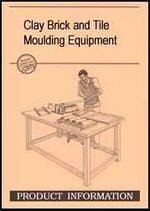Parry/ITW Clay Pantile production plant[edit | edit source]
Description
The Clay Pantile Production Plant is a further part of the ITW small-scale production plant and handling system for burnt clay building materials. It is a cost-effective, simple alternative to the traditional methods of clay roof-tile production. The production of clay pantiles with the Parry/ITW plant is a purely manual operation, in which only local materials are processed.
The main equipment is a preparation table, on which a roller press and tile stand are mounted, and on which the raw clay is shaped to pantiles and placed on special forms for drying. Furthermore a steel box with a cutting frame is provided together with a bow cutter to cut uniform clay bats, as well as a shaping tool into which the bats are placed. Most of the ITW equipment used for brick-making (eg clay crushers, portable clay hoppers, carrying racks 3-wheel trucks) are also designed for use in pantile production.
The approximate dimensions of the finished clay pantile are 350 x 270 x 11 mm thick. The effective coverage is approx. 270 x 230 mm (about 16 tiles per square metre of roof surface).
FIGURE
FIGURE
FIGURE
|
Clay Pantile Production Plant | |
|
Size of preparation table (length x width x height) |
123 x 71 x 105 cm (48 x 28 x 41 in) |
|
Weight of preparation table |
65 kg |
|
Size of crate for shipment (CT 500) |
|
|
Weight of packed plant |
106 kg |
|
Standard tile size |
35 x 21 x 1.1 cm (13.8 x 10.6 x 0.43 in) |
|
Effective roof coverage S no. of tiles per m² |
27 x 23 cm (10.6 x 9 in)/16 |
|
Energy input/transmission |
manual/mechanical |
|
No. of tiles per cycle/output rate |
1 / 30 - 50 tiles per hour |
|
Labour force required (incl. clay preparation and stacking) |
1 - 5 men |
|
Price (FOB) valid June 1991 |
Optional plant sizes acc. to weekly tile output: 500,1000,2000 | |
|
CT 500 |
6185 £ Sterling (» 10830 US0 | |
|
CT 1000 |
8085 £ Sterling (» 14150 US0 | |
|
CT 2000 |
11835 £ Sterling (» 20720 US0 | |
|
Included in each plant are: |
Clay rollers, moulds, clay crusher, clay hopper, carrying frames, 2-wheel and 1/4 tonne ground lift truck | |
How a clay tile is made
- A clay bat is thrown into the cutting frame. The excess is cut off with the bow cutter and re-used.
- The outer box of the frame is removed by sliding upwards.
- The large bow cutter is used to cut the clay into bats. The frame has slots to guide the cutter.
- The clay bat and the shaping tool is dusted with sand and the bat is laid on the shaping tool. The surface is dusted with sand to prevent sticking.
- The shaping tool with the bat on it is rolled through the roller press. This forms the bat into the correct tile shape and thickness.
- Tile and shaping tool are placed on the stand and the trimmer is drawn along the edges to cut off the excess clay.
- The drying form is placed on top of the tile, and holding the two together is lifted and fumed over.
- The shaping tool is removed, leaving the tile in position on the drying form.
- Then it is transferred to the carrying rack.
- When full, the carrying rack is picked up by the 1/4 tome truck and taken to the drying racks.
- The forms are then placed on the covered drying racks where they harden for one or two days.
- Then they are taken to the drying ground where they are removed from the drying forms and stood on edge for final drying before firing.
File:Bricks P12.GIF
FIGURE

